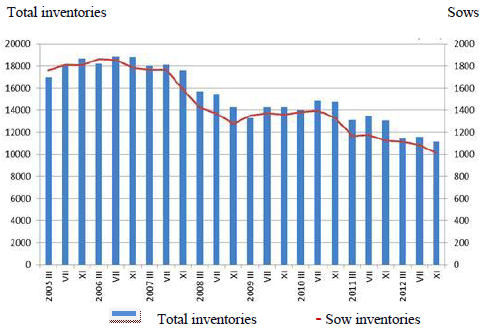



Polish Swine Sector Under Stress
POLAND - In December 2012, Polish swine inventories totalled 11.1 million head, a 15 per cent drop in comparison to the same period of previous year and a 40 per cent decline over the last six years.Low production efficiency, lack of vertical integration and inefficient farm structure consisting mostly of small-to-medium-sized operations are the catalysts for the historical drop in the national swine herd.
The swine sector’s current challenges, however, create opportunities for US suppliers of swine genetics and animal products.
Poland faces a historical drop in its swine inventory resulting from an inefficient production structure acerbated by high feed costs.
The contraction of the national swine herd started shortly after Poland’s EU accession and steadily continued but for a short break in 2009/2010.
Within the last six years swine numbers have decreased by over 40 per cent.
Inventories of sows in December 2012 totaled to 1,012,000 head, a ten per cent decrease in comparison to the December 2012 figure.

Although the average price for slaughter hogs in 2012 (January-December) was 19.3 per cent higher year-over-year, the contraction of the swine sector is expected to continue in 2013 due to high feed costs, inefficient structure of the industry and the continuing strong competition from Dutch, Danish and German suppliers of pork and piglets.
In December 2012 the average price for feed grains was 27 per cent higher year-over-year.
Low profitability in swine production is translating to decreasing number of bred sows that leads to shortages and higher prices for replacement piglets.
In December 2012, the number of bred sows was five per cent lower than reported in July 2012 and two per cent down from December 2011.
In 2012 the estimated slaughter of hogs (official data will be available in May 2013) was six per cent lower than in 2011 resulting in reduced production of pork.
Lower rate of hog slaughter is forecast in 2013 due to the lower swine inventory and expected growth in pork imports. On-farm slaughter is expected to remain level at 15 per cent of total slaughter.
Consumption
In 2012, average annual per capita consumption of pork amounted to 40 kilograms (88 pounds) compared to 26 kilograms of poultry meat (57 pounds) and 2.2 kilograms of beef (5 pounds).
In 2013, consumption of pork is expected to decrease because of lower domestic output, rising retail prices and substitution by cheaper poultry meat.
The Polish consumers’ preference towards pork will stimulate imports of cheaper products and will encourage the government to introduce measures supportive of the industry.
Trade
Poland is a net importer of pork and live pigs as a result of its declining bred sow population.
The shortage of piglets is stimulating imports to rise and mainly from Denmark.
In 2012, imports of piglets are estimated at 3.55 million head (over 30 per cent increase compared to the previous year).
Rising imports of piglets is forecast to continue in 2013 due to high prices on the domestic market coupled with ongoing consumer demand for pork.
The shortage of quality pork on the domestic market in turn, is expected to stimulate higher imports from EU Member States in 2013.
In 2013, Polish exports of pork are expected to grow mainly to third countries while sales within the EU market are expected to stabilize.
It is expected that in 2013, for the first time, exports to third markets will equal those to the EU market.
In the first ten months of 2012, exports of pork and pork products to Ukraine and Japan increased by 50 and 45 per cent, respectively, in comparison to the same period of previous year.
In 2012, Poland initiated exports of pork to China (10,000 MT in the first ten months of 2012).
The Ministry of Agriculture aggressively supports the Polish pork promotional campaign in third markets and negotiation of health certificates with new trading partners.
Policy
In order to address difficult situation challenging the Polish swine and pork industries the Ministry of Agriculture, in cooperation with the Polish Association of Swine Producers (POLSUS), is preparing a program to re-vitalize the swine industry.
The program is expected to focus on support to medium and large-scale producers of piglets and on enhancement of vertical integration of the industry.
The Agricultural Minister announced that the program would be partly financed from the EU rural development program in 2014-2020 and that it is expected to result in an increase of swine numbers from the current 11 million head to 18 million head within next ten years.
Although imports of live hogs and pork from Denmark, the Netherlands, and Germany appear to be destabilizing domestic swine production the imports clearly reveal that Polish swine producers are not competitive with producers from Western Europe.
Low efficiency of production, lack of vertical integration and inefficient structure of farms based mostly on small to medium-sized operations positions Polish producers in the role of contract feeding operations raising piglets imported from Western Europe.
Market Opportunities
In order to become competitive Polish farmers must focus on improving the genetics within the national herd, principally the production traits.
Number of piglets per litter and better feed conversion will have to be improved in order to counteract current competition from Western European suppliers of piglets.
Polish farmers claim that although price for piglets imported from Western Europe often are the same or slightly higher than for piglets produced locally, the imported animals perform much better during the growing out and finishing process.
The Polish swine sector’s current challenges create opportunities for US suppliers of swine genetics in the form of semen or live breeding animals.
With implementation of the Commission Regulation (EU) No 102/2013 of 4 February 2013, the European Union now allows import of live pigs for breeding and production from the United States subject to test negative for vesicular stomatitis disease.








